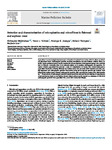Detection and characterisation of microplastics and microfibres in fishmeal and soybean meal
| dc.contributor.author | Walkinshaw, C | |
| dc.contributor.author | Tolhurst, TJ | |
| dc.contributor.author | Lindeque, PK | |
| dc.contributor.author | Thompson, Richard | |
| dc.contributor.author | Cole, M | |
| dc.date.accessioned | 2022-11-03T13:43:53Z | |
| dc.date.issued | 2022-12 | |
| dc.identifier.issn | 1879-3363 | |
| dc.identifier.issn | 1879-3363 | |
| dc.identifier.other | 114189 | |
| dc.identifier.uri | http://hdl.handle.net/10026.1/19835 | |
| dc.description.abstract |
Aquaculture is an increasingly important source of nutrition for global food security, which is reliant on animal- and plant-based feeds. Anthropogenic particles, including microplastics and semi-synthetic cellulosic fibres, are prolific marine pollutants that are readily consumed by marine organisms, including small pelagic fish commonly used in fishmeal. Conversely, there is no indication plants can accumulate anthropogenic microparticles. We explore whether aquaculture feed presents a route of contamination for farmed fish. Commercially-sourced aquaculture feedstocks, including fishmeals and soybean meal, were processed (KOH digestion and ZnCl2 density separation) and anthropogenic particles characterised using microscopy and spectroscopic methods. Both fishmeal and soybean meals contained anthropogenic particles, with concentrations ranging 1070-2000 particles kg-1. The prevalence of anthropogenic particles in plant-based feeds indicates that the majority of contamination occurs post-harvest. Based on our findings, farmed Atlantic salmon may be exposed to a minimum of 1788-3013 anthropogenic particles from aquaculture feed across their commercial lifespan. | |
| dc.format.extent | 114189-114189 | |
| dc.format.medium | Print-Electronic | |
| dc.language | en | |
| dc.language.iso | eng | |
| dc.publisher | Elsevier | |
| dc.subject | Fishmeal | |
| dc.subject | Microplastic | |
| dc.subject | Microfibre | |
| dc.subject | Cellulose | |
| dc.subject | Aquaculture | |
| dc.subject | Plastic pollution | |
| dc.title | Detection and characterisation of microplastics and microfibres in fishmeal and soybean meal | |
| dc.type | journal-article | |
| dc.type | Journal Article | |
| plymouth.author-url | https://www.webofscience.com/api/gateway?GWVersion=2&SrcApp=PARTNER_APP&SrcAuth=LinksAMR&KeyUT=WOS:000913116400001&DestLinkType=FullRecord&DestApp=ALL_WOS&UsrCustomerID=11bb513d99f797142bcfeffcc58ea008 | |
| plymouth.issue | Pt A | |
| plymouth.volume | 185 | |
| plymouth.publication-status | Published | |
| plymouth.journal | Marine Pollution Bulletin | |
| dc.identifier.doi | 10.1016/j.marpolbul.2022.114189 | |
| plymouth.organisational-group | /Plymouth | |
| plymouth.organisational-group | /Plymouth/Faculty of Science and Engineering | |
| plymouth.organisational-group | /Plymouth/Faculty of Science and Engineering/School of Biological and Marine Sciences | |
| plymouth.organisational-group | /Plymouth/REF 2021 Researchers by UoA | |
| plymouth.organisational-group | /Plymouth/REF 2021 Researchers by UoA/UoA07 Earth Systems and Environmental Sciences | |
| plymouth.organisational-group | /Plymouth/Research Groups | |
| plymouth.organisational-group | /Plymouth/Research Groups/Marine Institute | |
| plymouth.organisational-group | /Plymouth/Users by role | |
| plymouth.organisational-group | /Plymouth/Users by role/Academics | |
| plymouth.organisational-group | /Plymouth/Users by role/Researchers in ResearchFish submission | |
| dc.publisher.place | England | |
| dcterms.dateAccepted | 2022-09-26 | |
| dc.rights.embargodate | 2022-11-4 | |
| dc.identifier.eissn | 1879-3363 | |
| dc.rights.embargoperiod | Not known | |
| rioxxterms.versionofrecord | 10.1016/j.marpolbul.2022.114189 | |
| rioxxterms.licenseref.uri | http://www.rioxx.net/licenses/all-rights-reserved | |
| rioxxterms.licenseref.startdate | 2022-10-15 | |
| rioxxterms.type | Journal Article/Review |


